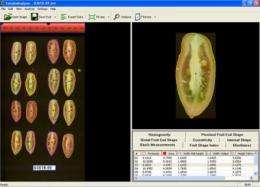New and improved tomato analyzer

Tomatoes come in a variety of sizes and shapes, making them the perfect subject to test shape-analyzing software. The Tomato Analyzer is "rapidly becoming the standard for fruit morphological characterizations," according to a study led by Marin Talbot Brewer of The Ohio State University's Department of Horticulture and Crop Science. Details of the team's latest Tomato Analyzer research were published in a recent issue of the Journal of the American Society for Horticultural Science.
Morphology studies the form and structure of organisms. Software such as the Tomato Analyzer aids in morphological research by providing accurate and objective measurements of fruit shape. The analysis is also more efficient for large numbers of subjects and can detect traits that are extremely difficult to quantify manually. The Tomato Analyzer uses mathematical descriptors to quantify various shape features based on the boundary of the fruit.
Morphometrics studies the quantitative analysis of the shape and size of a biological form using the position of and distance between landmarks. This method has been used to study variations, classifications, and evolutionary analyses, as well as genetic studies of animals and insects. Morphometric analysis is less biased and depends less on manual manipulation, but the results are abstract quantities. The Tomato Analyzer's results are more descriptive because they actually measure angles or include ratios that better explain the fruit shape. However, the Tomato Analyzer provides both methods in the same application, allowing the researcher to select the option that best suits the project's needs.
A main objective of the study was to investigate the quantitative trait loci (QTL), which are parts of the genetic code that control fruit shape. The QTL as determined by morphometric analysis and boundary analysis were then compared. A new set of measurements was added to the Tomato Analyzer software to calculate the area of the pericarp, septum, and placenta. These are internal segments of the fruit that help to explain the shape more thoroughly than the exterior silhouette alone.
In the 'Sausage' species of tomato, two loci were identified as controlling more than 50% of the internal shape index, which gives the tomato its elongated or "pear" shape. Visual observation supported that the software accurately measured the degree of pear shape. Additional tests to determine proximal end angle, the shape of the fruit nearest the stem, showed comparable results between the two methods. This adds to the software's versatility of measurements for researchers.
QTLs detected in 'Sausage' and 'Rio Grande' varieties of tomato overlapped significantly. Though most, if not all, of the QTL controlling fruit shape and size were identified using the Tomato Analyzer applications, morphometric analyses are an efficient way to investigate the various sizes and shapes of fruit. Because both types of analysis are available in the Tomato Analyzer, the software allows researchers to quickly note morphological variation with the morphometrics function and then delve more deeply into the details using the attribute function.
More information: The complete study and abstract are available on the ASHS Journal of the American Society for Horticultural Science electronic journal web site: journal.ashspublications.org/c … nt/abstract/134/1/77
Source: American Society for Horticultural Science


















